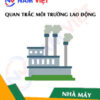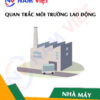Occupational environment monitoring of a bread manufacturing factory
99,000 ₫
Note: The above price is calculated for one sample, and the price may fluctuate depending on the area of the environment to be monitored and market movements. For more accurate pricing support, please refer to the price list or contact our consulting staff directly.
Monitoring the environment of a bread manufacturing factory is a session of collecting, analyzing, and evaluating factors at the workplace that may harm workers health.
Table of Contents
Toggle1. Overview of the Bread Manufacturing Factory
a. What is a Bread Manufacturing Factory?
Factory producing bread is a large or small production facility designed to produce and package daily bread products. This factory can use basic ingredients such as wheat flour, yeast, salt, sugar, and water to produce bread according to set processes and recipes. Modern bread factories often use advanced machinery, equipment, and technology to produce high-quality bread while meeting large-scale market demand. Bread products can be delivered to retail stores, supermarkets, restaurants, or exported to other countries for sale.

b. Production Stages in the Bread Manufacturing Factory
The production stages in a bread manufacturing factory typically include:
- Ingredient Preparation: This stage involves preparing basic ingredients such as wheat flour, yeast, sugar, salt, cooking oil, and water.
- Dough Mixing: Wheat flour, yeast, water, and other ingredients are mixed in a mixer until the mixture becomes rough and uniform.
- Dough Resting: After mixing, the dough mixture is left to rest for a period to allow the yeast to develop and the dough to rise.
- Dough Kneading: After resting, the dough is kneaded to remove air and ensure even and smooth dough.
- Shaping and Baking: The dough is shaped into bread loaves and baked in ovens. Bread factories often use large, specialized ovens to bake bread at precise temperatures and humidity for the best product quality.
- Cooling and Packaging: After baking, the bread is cooled and packed into bags or boxes for storage and transportation to retail stores or other points of sale.

c. Types of Machinery Used in the Bread Manufacturing Factory
Common machinery used in a bread manufacturing factory includes:
- Dough Mixer: This machine is used to mix basic ingredients such as wheat flour, yeast, sugar, salt, and water.
- Flour Grinder: This machine is used to grind wheat flour into a fine, uniform texture.
- Dough Kneading Machine: This machine kneads the dough after mixing to remove air and ensure even and smooth dough.
- Bread Press: This machine shapes the dough into round or square loaves.
- Oven: This machine is used to bake the bread. Ovens can vary in size and capacity to match the factory’s production needs.
- Packaging Machine: This machine is used to pack bread into bags or boxes for storage and transportation.

d. Occupational Diseases for Workers in the Bread Manufacturing Factory
Common occupational diseases in the bread manufacturing industry include:
- Allergies: Workers in bread factories may be exposed to allergens such as flour, yeast, flavorings, and preservatives, causing symptoms like nasal congestion, coughing, itchy skin, dermatitis, and other allergic reactions.
- Respiratory Diseases from Dust: Workers may be affected by dust inside the factory. Long-term inhalation of dust can lead to respiratory problems such as asthma, bronchitis, and loss of lung elasticity.
- Back Pain: Workers often stand for long periods and work in bent postures, leading to stress and back pain.
- Hand Disorders: Repetitive motions such as cutting, tearing, kneading, pulling, twisting, and pressing using tools like knives, forks, molds, or plastic containers can lead to issues in hands, wrists, and arms, including cervical spine degeneration, ligament injuries, and wrist sprains.

e. Popular Types of Bread on the Market
There are many popular types of bread on the market, depending on production methods, ingredients, and geographic regions. Some common types include:
- White Bread: Standard bread made from wheat flour, water, yeast, and salt.
- Barley Bread: Bread made from barley flour or a mixture of wheat and barley flour, sometimes combined with nuts or seeds such as cashews, sunflower seeds, and flax seeds.
- Whole Wheat Bread: Bread made from whole wheat flour, high in fiber and nutrients.
- Brioche: French bread made from wheat flour, eggs, butter, and sugar, with a sweet taste, often used for sandwiches.
- Baguette: French bread with a long, thin shape made from wheat flour, water, yeast, and salt.
- Sandwich Bread: Bread sliced thin and used to make sandwiches with meats, vegetables, eggs, cheese, and various condiments.
- Italian Bread: Bread made from Italian flour, flavorful and combined with spices and sauces.
- Golden Bread: Bread made from golden flour, sweet in taste, often used for sandwiches.
- Black Bread: Bread made from dark flour or mixed with coffee, cocoa, or other flavorings, with a special and appealing taste.

2. Overview of Occupational Environment Monitoring Services
a. What is Occupational Environment Monitoring in a Bread Factory?
Occupational environment monitoring (or workplace environment measurement) in a bread manufacturing factory is the activity of collecting, assessing, and analyzing measurement indicators of workplace environmental factors to implement timely measures, reduce environmental hazards to workers’ health, and prevent occupational diseases. Occupational environment monitoring is mandatory for bread factories.
Occupational environment monitoring plays a crucial role in caring for, protecting, and enhancing workers’ health because the main resource of a business and its direct profit generator is the workforce. Workers regularly exposed to excessive occupational hazards beyond allowable limits can be affected health-wise and develop occupational diseases.
REGISTER FOR OCCUPATIONAL ENVIRONMENT MONITORING SERVICE
b. Nam Viet’s Occupational Environment Monitoring Program
Nam Viet’s occupational environment monitoring program is researched by monitoring engineers specializing in labor safety and environmental protection. Aiming to ensure the health and safety of workers, this program uses modern measurement methods to monitor air quality, water, microclimate factors, physical parameters, and dust in the workplace. This program is crucial for maintaining a safe working environment and protecting workers’ health.
Furthermore, Nam Viet’s occupational environment monitoring program also plays an important role in researching and developing new solutions to improve workplace environmental quality. With the dedication and professionalism of its monitoring experts, Nam Viet’s exclusive monitoring program has become a breakthrough in labor safety management and environmental protection in Vietnam.

c. Standardization in Workplace Environment Measurement Procedures
Standardization in Nam Viet’s workplace environment measurement procedures is critical for ensuring the quality of measurement results. To ensure accuracy and reliability, the program uses recognized standards and standardized procedures from the Ho Chi Minh City Department of Health. This ensures that collected data can be reliably used to assess the workplace environment and make decisions to improve it and protect workers’ health.
These standardized procedures also guarantee that measurements are conducted by a highly qualified team of monitoring specialists with years of experience, enabling managers and experts to trust An Toan Nam Viet’s results and make accurate, valuable decisions for protecting worker health and the environment.
By applying standardized measurement procedures, Nam Viet demonstrates its commitment to ensuring a safe working environment and protecting worker health while actively contributing to improving labor safety management and environmental protection quality in Vietnam.
d. Bread Factory Monitoring Report
Occupational environment monitoring results are prepared according to Form No. 04 Appendix III issued with Decree 44/2016/ND-CP and are prepared in two copies: one sent to the contracting workplace and one retained by the monitoring organization.
The retention period for occupational environment monitoring results is indefinite as per legal regulations.

e. Frequency of Workplace Environment Monitoring as Required by Law
According to Clause 2, Article 18 of the Law on Occupational Safety and Hygiene 84/2015/QH13, employers must conduct workplace environment monitoring to assess harmful factors at least once a year.
f. Deadline for Submitting Workplace Environment Monitoring Reports
The deadline for submitting reports is before December 31 each year. Enterprises at production facilities must submit occupational environment monitoring reports to the local Department of Health where the facility has its headquarters and where workers are employed.
When there are changes in technology, production processes, or facility upgrades that may introduce new hazards to worker health, enterprises must update occupational hygiene records regarding harmful factors that need monitoring.
g. Penalties for Violations of Workplace Environment Monitoring by Employers
According to Article 27 of Decree No. 12/2022/ND-CP dated January 17, 2022, regulating administrative penalties in labor, social insurance, and Vietnamese workers going abroad under contracts:
- Clause 2: A fine of 2,000,000 – 5,000,000 VND for employers who do not publicly announce monitoring results to employees at the monitored workplace and where hazard control is evaluated immediately after obtaining the results.
- Clause 3: A fine of 20,000,000 – 40,000,000 VND for employers who fail to conduct workplace environment monitoring to control hazards to workers’ health as required by law.
- Clause 4: A fine of 40,000,000 – 60,000,000 VND for employers who cooperate with monitoring organizations to commit fraud in monitoring activities but do not reach the level of criminal liability.
3. Harmful Environmental Factors for Workers in Bread Manufacturing Factories
In bread manufacturing factories, there are several environmental factors that can negatively impact workers’ health, including:
- Flour dust and particles: During bread production, flour dust and particles can become airborne, irritating workers’ respiratory systems. Prolonged exposure to high levels of flour dust can cause allergies or pneumonia.
- Chemicals: Certain chemicals may be used to enhance product durability and color. Improper use or lack of safety measures can be harmful to workers’ health.
- Noise: Machinery in bread factories can produce loud noise, affecting health and reducing quality of life.
- Temperature: Equipment such as ovens can generate high temperatures, causing discomfort and impacting workers’ health.
- Lighting: Strong lighting in the factory can cause eye strain and discomfort.
REGISTER FOR OCCUPATIONAL ENVIRONMENT MONITORING SERVICE
4. Measures to Improve the Working Environment in Bread Manufacturing Factories
To improve the working environment in bread factories, the following measures can be applied:
- Use personal protective equipment: Provide workers with masks, safety glasses, gloves, and protective clothing to safeguard health when exposed to harmful substances during production.
- Ensure environmental hygiene: Maintain a clean, well-ventilated workspace to minimize airborne flour dust and ensure food safety.
- Increase supervision: Regularly monitor and evaluate occupational safety to ensure all safety regulations are effectively implemented.
- Use modern machinery: Apply advanced production technology and modern equipment to reduce noise, heat, and dust in bread production.
- Training and awareness: Train employees on production processes, occupational safety, and environmental hygiene, raising awareness of environmental hazards and ways to protect their health.
- Regular health checks: Conduct periodic health examinations for workers to detect and address any health issues arising from exposure to environmental factors in the factory.
- Regularly conduct occupational environment monitoring in factories, collecting and analyzing harmful factors, and adjusting measures to reduce risks and prevent occupational diseases.
5. Benefits of Periodic Monitoring in Bread Manufacturing Factories
An Toan Nam Viet provides enterprises with excellent benefits when using occupational environment monitoring services according to Decree 44/2016/ND – CP on managing and controlling harmful factors in the working environment affecting employees.
- Enterprises can proactively control harmful factors in workshops or factories.
- Receive consultation and recommendations to reduce harmful factors and improve workplace quality.
- Indirectly protect human resources, a key factor in business development.
- Reduce the impact of occupational diseases on health, minimizing future treatment costs.
- Improved employee health enhances product quality and maintains consistent production output.
- Comply with occupational safety laws, avoiding legal risks.
- Enhance credibility and professionalism, thereby elevating the enterprise’s brand.
Nam Viet’s environmental monitoring service is a solution to reduce occupational disease risks, contributing to a clean and high-quality working environment.

6. Nationwide Occupational Environment Monitoring Center
Occupational Environment Monitoring Center of Nam Viet is a professional unit specializing in monitoring and measuring occupational environment quality across all provinces in Vietnam. With an experienced team of monitoring specialists, the center uses modern measurement equipment to ensure accuracy and reliability.
In addition to providing monitoring services, the center assists clients in planning, handling, and tracking occupational environment issues. Following the principle “customer-centered,” the center prioritizes client satisfaction, meets all client needs, and commits to providing the best solutions for enterprises.
REGISTER FOR OCCUPATIONAL ENVIRONMENT MONITORING SERVICE
With investment in technology, equipment, and human resources, Nam Viet’s monitoring center has become a reputable unit in occupational environment monitoring in Ho Chi Minh City, with the following goals:
- We always value brand reputation and service quality.
- We provide clients with the best and most suitable solutions.
- Alongside experienced Masters and Engineers, aiming to protect the environment and benefit enterprises.
- By choosing Nam Viet Environmental Monitoring, your company will receive professional service from experts in monitoring, along with the best cost incentives.
The occupational environment monitoring process at Nam Viet includes the following steps:
- Before monitoring, we ensure that all machinery and equipment used for monitoring are calibrated and compliant with legal regulations.
- Conduct the full monitoring procedures as committed to the Department of Health.
- Report monitoring results honestly to the employer.
- If results indicate unsafe conditions, Nam Viet will assist with corrective measures, and the factory will implement the following:
- Implement measures to improve working conditions, minimize harmful factor impact, and prevent occupational diseases.
- Organize health checks for early detection of occupational and work-related diseases for workers in unsafe positions.
- Provide material compensation for workers according to labor law regulations.

7. Occupational Environment Monitoring Price List
To help enterprises conduct occupational environment monitoring professionally and effectively, Nam Viet provides clients with a price list for occupational environment monitoring services that is high-quality and reasonably priced.
- Our price list provides detailed information on the costs of monitoring services, including transportation, measurement, analysis, and reporting. Clients can fully trust the accuracy and reliability of our monitoring reports.
- We commit to offering competitive and reasonable prices and are always ready to answer any questions about monitoring services promptly and professionally.
- With Nam Viet’s price list, clients can easily select service packages that suit their needs. We guarantee the highest satisfaction with professional service quality.
No comments yet












Review Occupational environment monitoring of a bread manufacturing factory
There are no reviews yet.